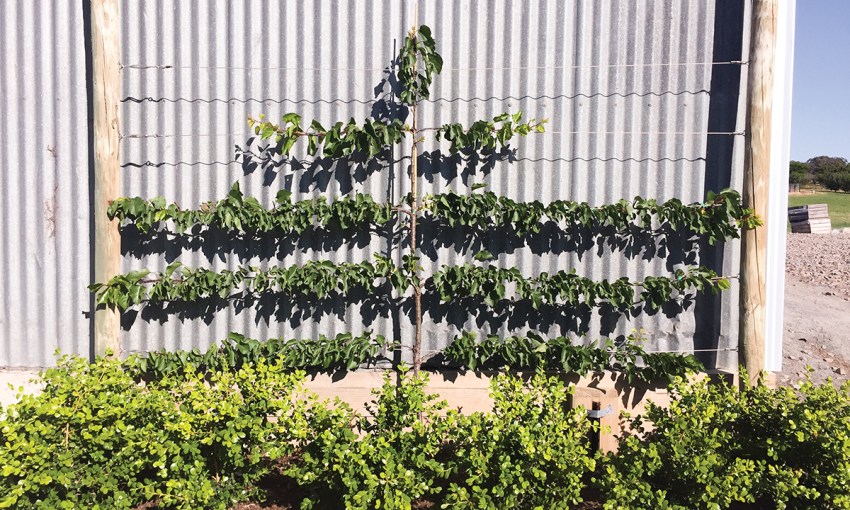Want to enjoy delicious home-grown fruit but you lack the space for a full-sized fruit tree? Let’s talk about growing fruit trees where space is limited.
Fruit trees for small spaces
Espaliering fruit trees
Garden lovers grow trees as an espalier if they have a fence or wall to cover or a deck rail to grow a tree alongside. This training technique allows a fruit tree to grow on a narrow “two-dimensional” framework. Espaliering fruit trees does require more effort than growing a free-standing tree but the process can be enjoyable and rewarding and the result can add a touch of class to your garden.
The trellis Space the posts 3.5-4.5m apart. Anchor posts well into the ground to withstand the tension of the wires. Install the horizontal wires between the posts, with the first wire being approximately 40-50cm above the ground, corresponding to the lowest limbs on your tree, followed by wires spaced at 25-30cm to the top of your posts.

The tree Select a tree that ideally has two suitable limbs at roughly 40cm from soil level. Prepare your soil with some gypsum and some organic fertiliser (not too strong, to avoid burning the roots) and plant the tree ensuring it is straight and well centred between the two posts.
Training Bend the lowest limbs of your tree to the lowest wire of your trellis and secure with cloth/horticultural ties.
Cut the trunk 10cm or so above the second wire. When the buds shoot near the wire then train two lower shoots horizontally along the second wire and allow one of the top buds to grow upwards to the next wire (making an extension of the trunk). Other shoots can be removed. As the lower branches grow, they should be gently tied along the length of wire.
The process is then repeated until the tree has reached the full height of the trellis.


Watch out for Scorching from hot, reflective surfaces. Counter this by painting reflective surfaces and/or by erecting the trellis 30-40cm away from these structures to allow air circulation.
Benefits of espalier
• Trees are easy to net
• Keeps tree to a manageable size
• Allows good sunlight penetration to yield good crops
• A beautiful garden feature to hide a wall or fence, or to edge a deck
• Requires only light pruning once established

Growing fruit trees in pots
It’s true that most fruit trees would prefer to grow in the soil so their roots can access a greater volume of soil for water and nutrients. But if you only have a small back yard or just a good size deck/patio, you can still enjoy fresh fruit by growing trees in pots.
The pot Firstly, choose the biggest pot you can. A half wine barrel is best, but nothing smaller than 60cm diameter should be used or the tree will become pot-bound too soon.
The mix Never use a cheap potting mix for potting plants that will be kept in pots for a long time. Poor quality potting mixes will break down too quickly, lack good long-term nutrition, are hard to re-wet if they dry out and may not have good porosity. Choosing a premium potting mix will provide the best start for your potted tree. You may like to add some gravel to the bottom of the pot first to keep the bottom layer very free-draining and mix some water-saving granules into the mix to prevent it drying out in summer.

The tree If you can buy dwarf fruit trees this will help keep the tree in the pot for a longer period of time, but whether you plant a full-size tree or a dwarf, your fruit tree will need to be pulled out of the pot every three or four years (more regularly for smaller pots), to trim all the roots lining the inside of the pot by 25-50mm. Re-potting is best carried out at the end of winter before the spring growth starts, and provides an ideal opportunity to upsize your pot and to add some fresh potting mix to keep your fruit tree growing.
Training tip If you have seen fruit trees in commercial orchards they are often trained so that their lateral branches are tied down to a horizontal position – this helps control the vigour of the tree. This technique can be used on all deciduous fruit trees to slow their growth and keep them smaller in size. Use string and a tent peg to secure the branch in place.
Benefits Growing your home orchard in pots means that if you have to move home, your orchard can go with you! It also allows you to rotate your trees to get sunlight into all sides, which helps maintain healthy, well-formed trees.

This article first appeared in the Winter 2021 issue of SALIFE Gardens and Outdoor Living magazine.



